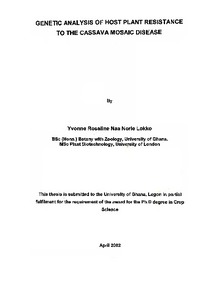| dc.contributor.author | Ngobo, M. |
| dc.contributor.author | Weise, S. |
| dc.contributor.author | Mc Donald, M. |
| dc.date.accessioned | 2019-12-04T11:30:52Z |
| dc.date.available | 2019-12-04T11:30:52Z |
| dc.date.issued | 2002 |
| dc.identifier.citation | Ngobo, M., Weise, S. & McDonald, M. (2002). Influence of fallow land-use intensity on weed dynamics and crop yield in southern Cameroon. In 5th EWRS Workshop on Physical and Cultural Weed Control. Pisa, Italy, 11-13 March 2002, Institut de malherbologie: Canada (p. 41-44). |
| dc.identifier.uri | https://hdl.handle.net/20.500.12478/5405 |
| dc.description.abstract | The influence of weeds community composition and dynamics on groundnuts intercropped with
cassava was assessed in three different short fallow management systems, in the Forest Margins
Benchmark Area of southern Cameroon (Central Africa). Fallow management intensities, indicated through differing fallow types, consisted of: recurrent Chromolaena odorata-dominated fallows (type I), C. odorata-dominated fallows that had been forest prior to the cropping phase (type II) and bush fallows not dominated by C. odorata that had previously been forest (type III). Weed species diversity, weed density and weed cover percentage were evaluated at six, 14 and 30 weeks after planting, in 30 mixed crop fields. Soil properties were determined at the beginning and at the end of the cropping period. Results showed that C. odorata thickets regulate the weed flora in natural short fallow-food crop farming systems of southern Cameroon. However, C. odorata seemed to have a detrimental effect on food crop productivity in 5-7 years old fallows. Cassava yields even appeared to be greater in recurrent fallow lands dominated by that asteraceous weed species |
| dc.description.sponsorship | United States Agency for International Development |
| dc.language.iso | en |
| dc.subject | Weeds |
| dc.subject | Groundnuts |
| dc.subject | Cassava |
| dc.subject | Fallow |
| dc.subject | Mixed Cropping |
| dc.subject | Soil Properties |
| dc.title | Influence of fallow landuse intensity on weed dynamics and crop yield in southern Cameroon |
| dc.type | Conference Paper |
| cg.contributor.affiliation | University of Wales |
| cg.contributor.affiliation | International Institute of Tropical Agriculture |
| cg.coverage.region | Africa |
| cg.coverage.region | Central Africa |
| cg.coverage.region | West Africa |
| cg.coverage.country | Cameroon |
| cg.coverage.country | Nigeria |
| cg.authorship.types | CGIAR and advanced research institute |
| cg.iitasubject | Weeds |
| cg.accessibilitystatus | Limited Access |
| local.dspaceid | 103762 |

